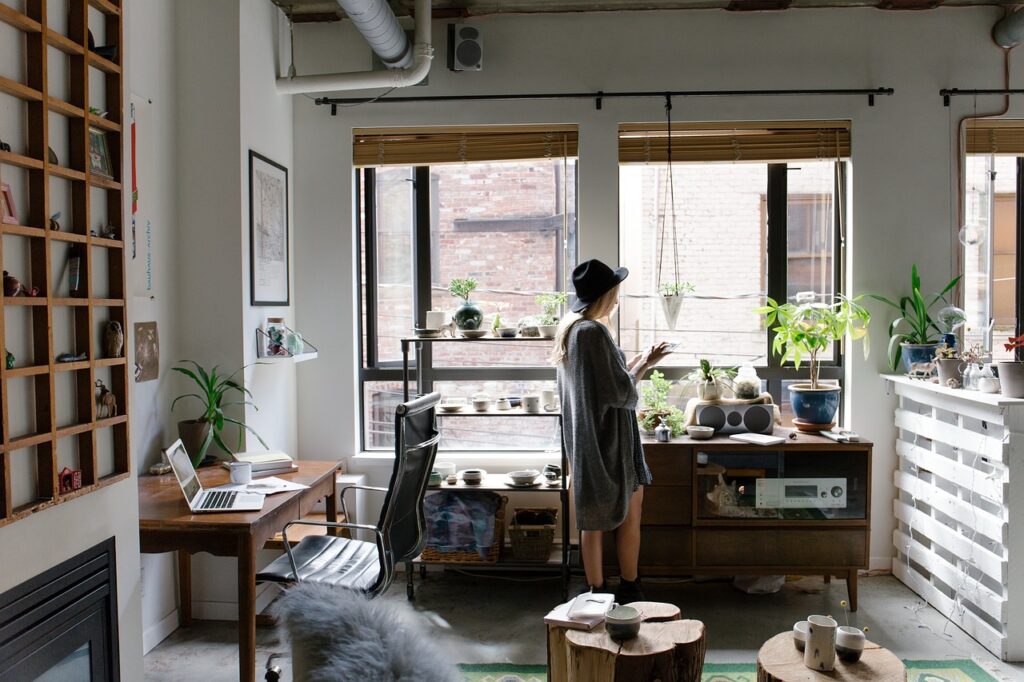Are you part of the creative class that works mostly from home? Are you a freelance writer trying to make a living from your craft, or do you write just because it satisfies a creative need and brings you joy? Do you set aside time each day for your journaling practice? No matter what your reason for writing—for profit or pleasure—if you work from home, you’ll want to create a writing space that is all your own.
Whether you have a large home and you have a separate room to write in with a door, or you’ve set up your computer in a nook underneath the stairs just off the kitchen, these tips for setting up a beautiful writing space at home will make any work in progress feel like a blooming bestseller!
1. Create an Inspiring Ambiance
Is your chair comfortable? Do you have fresh air flowing around your desk? Is the lighting strong enough, or is it too bright? Can you position your writing space in such a way that you can use natural light for most of the day? Having a healthy, fresh workspace will keep your energy levels up and encourage you to write more frequently and with greater enthusiasm.
2. Keep It Clean
Finding a calm, inviting, and inspiring workspace doesn’t mean that you have to have a fancy desk or a pretty view of the ocean. Your writing space doesn’t need to be big, just big enough to hold your favorite writing tools, books, and mementos. If you have a small space, especially a small space in your home, guard it carefully. Keep non-writing clutter at bay. Don’t let your workspace become a catch-all dumping ground for things that don’t serve your writing practice.
3. Limit Distractions
Choose a place to write that helps you to stay focused on your work for reasonable amounts of time. Keep non-work gadgets at a safe distance away from your writing space.
TVs, video games, and other electronic appliances, including vacuums, dishwashers, and washing machines, can distract you from your writing projects. Soon that pile of laundry you stopped to do will divert you to the dishwasher that needs to be loaded, and then “Oh, the floor needs sweeping!” Before you know it, your house is clean, but you’ve fallen behind on your writing project deadline.
4. Make Yourself Comfortable
This is your journaling studio, and you don’t have to ask for permission to modify your workstation—you are the boss!
Here are some things that you can do in your home office that you probably can’t do at work:
- Choose your paint colors. No more boring corporate beige! Paint the wall above your desk a color that makes you feel creative and full of positive energy.
- Create your own playlist and crank it up to whatever volume you like! Do some of your favorite songs contain NSFW lyrics? No problem! If you like to listen to music when you write, then set up a good quality sound system, whether it’s just your iPhone with earbuds or a surround sound system hooked up to your desktop computer.
- Sitting for too long is now recognized by many health professionals as a serious concern. Unfortunately, not all office managers and bosses agree, and many people who work outside of the home have to sit all day. But when you work from home, you get to decide how long you sit and stand each day. You could consider designing a writing space that has multiple surfaces of varying heights and then move your laptop or keyboard from sitting to standing heights throughout the day.
- Use feng shui to help you choose the best place to position your desk. For example, ideally, you should position your desk in what’s called the command position; that is, you are sitting facing the door so that you can see anyone who enters your room. There is nothing worse than being caught up in your writing, head down, eyes glued to your paper or screen, and having someone walk up behind you and scare the living daylights out of you.
5. Glimpse Into a Few Famous Writers’ Hideouts for Inspiration
Mark Twain’s writing space was painted a glorious shade of deep red. He brought in a large pool table and placed it in the center of the room. After all, when you’re faced with a spell of writer’s block—as all writers do—taking a break for a bit of playtime is always a smart idea.
Virginia Woolf, who famously said, “A woman must have money and a room of her own if she is to write fiction,” did most of her writing in a toolshed with a garden view, a plain wooden table, and an oil lamp.
Like many writers, George Bernard Shaw preferred to work in solitude. Of his writing space, which consisted of a white painted desk, a wicker chair, and a typewriter, “People bother me. I came here to hide from them.”
You can check out gorgeous pictures of the studios, offices, and hideouts of some of the world’s most creative people at thewrite life.com.
6. Take Yourself Seriously
The most important thing in designing your writing space is that it makes you feel like a serious writer, with serious work to do—even if you are writing as a hobby. A good writing space will inspire you to be disciplined. It will make sitting down to work every day feel like a treat.
Journaling Prompt: Do a 5-7 minute journal entry on what your ideal journaling space looks like. When you are done, reread your description and pick one desired feature of your journaling studio that you could start working on. What are the next steps you need to take to get started on creating this feature?

